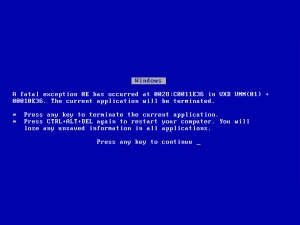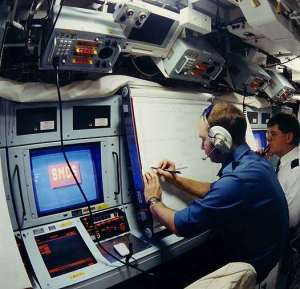Submarine Command System
A press release from BAE Systems announced the installation of the Submarine Command System Next Generation (SMCS NG) on twelve nuclear submarines of the Royal Navy, effectively ending the conversion of the seven Trafalgar-class submarines, four Vanguard-class submarines and one Swiftsure class[1].
The new command system is based on COTS hardware and software products. It uses mainstream PCs and Windows as supporting components. All computers are connected with on a LAN by an Ethernet network using fiber-optic cable. According to The Register, the system will mostly be based on Windows XP[2] although in was initially decided it would be based on Windows 2000.
The role of this system is to store and compile data from various sensors in order to present tactical information for the leadership. It also controls the weaponry:
SMCS NG is designed to handle the growing volume of information available in modern nuclear submarines and to control the sophisticated underwater weapons carried now and in the future. Its core capability is the assimilation of sensor data and the compilation and display of a real time tactical picture to the Submarine Command Team[3].
The SMCS NG system is the descendant of the previous SMCS system that was proposed back in 1983, when the U.K decided to build a new command system for the then-new Trident class. Before, all electronics were custom built by Ferranti. The SMCS would use COTS material to minimize the costs and become fewer dependants on one company. The architecture of the command system was modular and was written in Ada 83. The core of the system contains an Input/Output computer node, a computer that process data from the sensors and weapons systems. There is also the central node, which is used for processing all the data. Each of the central nodes are duplicated to provide of fault-tolerance, with each being dual modular tolerant, which means that hardware components are working in parallel in case one becomes defective. The dual central nodes are connected to each other and they are also connected to Multi Function Consoles, a Main Tactical Display and two Remote Terminals, which provide the Human Computer Interface. The first phase of the project was to install the SMCS on the Vanguard class submarines.
In 1990, it was decided to extend the SMCS to other submarine classes and that the new command system would use UNIX as its base operating system. Because of the Ada architecture, problems arose when the technicians tried to map the SMCS to run-time processes of UNIX. Solaris and SPARC machines were finally selected for Multi Function Consoles. The central nodes kept their original architecture in Ada.
In 2000, the project was completely own by BAE Systems and the move from SPARC computers to PCs. The switch for the operating system was more difficult, as management preferred Windows while the engineers promoted the use of variants of UNIX such as BSD, Linux or Solaris. The main argument for the engineers was that with UNIX, it would be possible to remove all the extra code unneeded for the submarines operations, thus making it more secure. However, the management point of view prevailed and thus was created the “Windows for Warships” label.
Windows was chosen even after the USS Yorktown accident in 1997, in the US. The ship was crippled after the sysadmin entered invalid data into the database thought the Remote Database Manager.[4]
Insert any jokes about Windows controlling nuclear subs into the comments. Thank you.
 |
 |
See also:
“SMCS“, AllExperts, http://en.allexperts.com/e/s/sm/smcs.htm (accessed on December 17, 2008)
“Submarine Command System (SMCS)“, Ultra Electronics, http://www.ultra-ccs.com/systems/smcs/ (accessed on December 17, 2008)
“Operating Systems Contracts, Trusted Software?“, Richard Smedly, Linux Format, March 2005, http://www.linuxformat.co.uk/pdfs/LXF64.pro_war.pdf (accessed on December 17, 2008)
“Development Drivers in Modern Multi-function Consoles and Cabinets“, Armed Forces International, http://www.armedforces-int.com/categories/military-consoles-and-cabinets/development-drivers-in-modern-multifunction-consoles-and-cabinets.asp (accessed on December 17, 2008)
[1] “Royal Navy’s Submarine Command System Installation Programme Completes Ahead of Time”, BAE Systems, December 15, 2008, http://www.baesystems.com/Newsroom/NewsReleases/autoGen_108111514515.html (accessed on December 17, 2008)
[2] “Royal Navy completes Windows for SubmarinesTM rollout”, Lewis Page, The Register, December 16, 2008, http://www.theregister.co.uk/2008/12/16/windows_for_submarines_rollout/ (accessed on December 17, 2008)
[3] Ibid.
[4] “Operating Systems Contracts, Trusted Software? “, Richard Smedly, Linux Format, March 2005, p.72




Open Windows Before Diving
Henk
February 17, 2009 at 4:08 pm